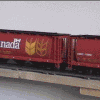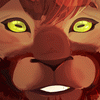
Hmm... havn't submit anything new in a while, so here's a plea to all you aspiring artists out there.
Please learn the differences between PNG, JPEG, and GIF.
Please learn the differences between PNG, JPEG, and GIF.
Category All / Doodle
Species Unspecified / Any
Size 400 x 457px
File Size 10.2 kB
Both GIF and PNG are lossless image formats, so they (usually) retain 100% of their detail every time you save the image. Since lineart has a lot of empty space, the Huffman algorithm used by GIF and PNG works best. JPEG (actually, JFIF) is a lossy compression format, and results in weird artifacts and quality loss evey time the image is saved, though for photos, it offers the best compression. PNG, and especially GIF, cannot compress photos and gradients very well.
GIF only allows a maximum of 256 colors, so images must be converted into indexed color before they may be saved. Lineart usually looks fine with 8-16 colors of grey. Specially prepared images with flat color, like mine, usually top out at 40-50 colors, with anti-aliasing. GIF is best used for animated images. For everything else, PNG is preferred, and more modern.
PNG allows for millions of colors, but it still works best with lineart. For photographs, PNG is only a realistic choice for archival purposes. PNG also allows gamma correction to be used, but if your computer isn't calibrated properly, that can destroy the image if you save it often, especially with old software that doesn't support gamma. PNG is great because it compresses better than GIF, if you use the right tools. Photoshop does a pretty bad job, though. Today, thankfully, Internet Explorer 7 now supports PNG transparrency, so for non-animated images, PNG should be used for everything instead of GIF. GIF is essentially obsolete.
JPEG is best for photos, and when used properly, will hardly show any real differences with the original image. JPEG works by splitting up an image into brightness and color. The color channel is resampled to a lower resolution, causing the sharp "chunky" look when using strong colors. The brightness is compressed using a lossy quantization algorithm, causing the "streaky" or "smeary" look. A quality setting of 8-9 (80%-90%) gives very good quality with photos and other images with smooth transitions. Linart and sharp color transitions will cause unacceptable artifacts, and will not produce files as small as PNG in most cases.
Tips: If you don't use gradients and want to save with fewer colors, use as many colors as possible and disable dithering. The result will usually offer better compression than with dithering on, despite using more colors.
When saving black-and-white JPEGs, make sure your software saves the image in greyscale, not color (aka "RGB", or "Red Green Blue"). Greyscale JPEGs are much smaller than RGB versions, even when the images contain no color. Never save JPEGs in CMYK color modes. Most programs do not read CMYK images properly, and the files are huge.
When saving as a JPEG, avoid using oversaturated colors to fill in objects with sharp edges, as they bleed and distort more than subdued colors. Red, green, and blue are the worst offenders.
GIF only allows a maximum of 256 colors, so images must be converted into indexed color before they may be saved. Lineart usually looks fine with 8-16 colors of grey. Specially prepared images with flat color, like mine, usually top out at 40-50 colors, with anti-aliasing. GIF is best used for animated images. For everything else, PNG is preferred, and more modern.
PNG allows for millions of colors, but it still works best with lineart. For photographs, PNG is only a realistic choice for archival purposes. PNG also allows gamma correction to be used, but if your computer isn't calibrated properly, that can destroy the image if you save it often, especially with old software that doesn't support gamma. PNG is great because it compresses better than GIF, if you use the right tools. Photoshop does a pretty bad job, though. Today, thankfully, Internet Explorer 7 now supports PNG transparrency, so for non-animated images, PNG should be used for everything instead of GIF. GIF is essentially obsolete.
JPEG is best for photos, and when used properly, will hardly show any real differences with the original image. JPEG works by splitting up an image into brightness and color. The color channel is resampled to a lower resolution, causing the sharp "chunky" look when using strong colors. The brightness is compressed using a lossy quantization algorithm, causing the "streaky" or "smeary" look. A quality setting of 8-9 (80%-90%) gives very good quality with photos and other images with smooth transitions. Linart and sharp color transitions will cause unacceptable artifacts, and will not produce files as small as PNG in most cases.
Tips: If you don't use gradients and want to save with fewer colors, use as many colors as possible and disable dithering. The result will usually offer better compression than with dithering on, despite using more colors.
When saving black-and-white JPEGs, make sure your software saves the image in greyscale, not color (aka "RGB", or "Red Green Blue"). Greyscale JPEGs are much smaller than RGB versions, even when the images contain no color. Never save JPEGs in CMYK color modes. Most programs do not read CMYK images properly, and the files are huge.
When saving as a JPEG, avoid using oversaturated colors to fill in objects with sharp edges, as they bleed and distort more than subdued colors. Red, green, and blue are the worst offenders.
How's Bitmap these days?
Jeeze, I took a class on this... about (over?) ten years ago, though, it's been too long since I took this in a test...
I have noticed Jpeg has raped a picture of mine. If I can find an original, or even the original art, I'll have to try and save it's integrity.
Jeeze, I took a class on this... about (over?) ten years ago, though, it's been too long since I took this in a test...
I have noticed Jpeg has raped a picture of mine. If I can find an original, or even the original art, I'll have to try and save it's integrity.

 FA+
FA+
















Comments